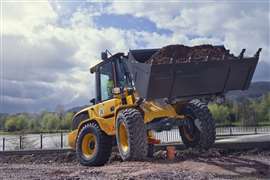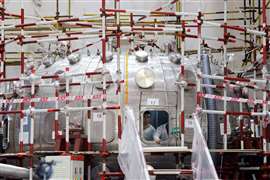Anti-entrapment: How manufacturers and MEWP users are responding to this safety issue.
19 June 2012

The new anti-entrapment devices shown at Intermat by both JLG and Genie sparked much discussion around the show. Genie was also allowing AFI-Uplift to show its Sanctuary Zone and Nationwide Platforms its SkySiren. Niftylift continued its commitment to its SiOPS - sustainable involuntary operation prevention system.
Some of the devices can be retrofitted others are built into the basket, they are all designed to prevent serious injury or fatalities occurring if a (usually) boom operator fails to notice an overhead obstruction and become trapped between the obstruction and the controls.
On most MEWPs the operator activates the platform motion via a foot pedal and manoeuvres it via the control panel. Should he become trapped between an overhead obstruction and the control panel he may not be able to deactivate the foot panel and his body is obstructing the control panel. In the best case scenario he is trapped until someone notices in the worse case he might be fatally injured.
When demonstrating the new devices representatives from both Genie and JLG were adamant in reiterating that their access platforms were intrinsically safe and the anti-entrapment devices were just another safety measure that could be employed.
JLG's Ron Jackson is at pains to make it clear that anti-entrapment devices are not a "fail safe" nor a substitute for appropriate levels of operator training and machine familiarisation but fall within the "environment of supplemental safety".
Scott Krieger, senior product manager, booms and telehandlers said, "The Genie team is aware of incidents where operators made contact with overhead obstacles while operating aerials. Ultimately, the operator, in conjunction with the worksite supervisor, is responsible for identifying and avoiding overhead obstacles. But as a secondary measure, Genie is working both independently and with various partners to provide protective solutions for a variety of worksite conditions."
JLG has developed Sky Guard to help boom operators avoid entrapment while working where there are overhead obstacles. The device was being demonstrated as a prototype and the company welcomes feedback from customers and platform users.
The Sky Guard is essentially a tape switch placed in a bar above the control panel - it has a range of activator points to accommodate users of different heights and positions on the machine. When appropriate force is applied to the bar the machine stops and a loud alarm sounds to alert people on the ground to the incident.
The device is configured to make a slight reverse in boom travel direction after activation to potentially free the operator to release himself. If the operator does release the foot pedal the machine re-sets and can be used as normal.
Additional safety
Genie's Operator Protective Structure (OPS) was also being shown as a prototype and is an optional device for installation on an articulating or telescopic boom
Based on of the concepts of other operator protective standards, the Genie OPS can be attached to booms with 6ft to 8ft platforms while maintaining excellent visibility. The tubular steel structure is designed to transfer the kinetic energy into surrounding structures while maintaining a protected envelope for the operator. It weighs 17kg (36lb) and is bolted directly on the boom's platform; no modifications are needed.
Concentrated work towards preventing the likelihood of injury due to crushing while operating a MEWP began in the UK in 2008 when the Health & Safety Executive, International Powered Access Federation (IPAF), manufacturers, plant and equipment suppliers, and the Construction Plant Association (CPA) got together to research and develop methods by which MEWP safety can be improved.
Following this work, the Strategic Forum for Construction Plant Safety Group introduced Best Practice Guidance for MEWPs - Avoiding Trapping / Crushing Injuries to People in the Platform.
The original guidance was launched by the industry in July 2010 to provide clarity about the safe use of MEWPs including planning, equipment selection, training, provision of information, familiarisation, safe use, supervision and rescue procedures, together with monitoring and management of the work. IPAF then prepared a US edition of the document, which was published in April 2011.
Although any good training course teaches the operator that he should be aware of surroundings and always look before operating the controls, it is easy to understand that while focusing on the job of work the machine operator might fail to check and a dangerous accident occur.
Industry statistics show that between 2003 and the summer of 2009 13 people lost their lives in the UK whilst using powered access equipment, at least six of which involved the elevated trapping of the operator in boom type MEWPs (IPAF Category 3b). Across industry, there have also been other serious accidents and near misses which could have resulted in the loss of life.
Not a panacea
At Intermat Access International sought the opinion of a number of senior industry members on anti-entrapment devices, few were prepared to go on the record. Dave Hall of Skyjack did say, "There is no panacea it is up to the operator to do thorough risk assessment and training."
John Ball managing director of rentals companies Height for Hire and EasiUplift agreed that the devices were no replacement for proper training and said that he understood that some users might not want the devices. He could, however, see an additional benefit if, for example, the operator were taken ill and slumped across the controls, the devices with an alarm would alert colleagues that someone were in difficulty.
"Not to make light of tragedies," said Mr Ball , "but I don't think it will ever become a legal requirement because the machines are intrinsically safe."
"However, contractors may stipulate anti-entrapment devices as a pre-requisite - it will come from the customer rather than being necessary. It starts with one contractor then it is the contagion effect."
Mr Ball may well be right, last year Skanska UK directed the use of additional entrapment protection on all boom-type (3b) Mobile Elevating Work Platforms (MEWPs). This covers all relevant equipment used by both its subcontractors and its employees across the approximately £1.3 billion worth of work it completes each year.
In 2008, a crushing fatality involving a MEWP occurred on a Skanska UK site and following this accident, Skanska became involved with the Strategic Forum for Construction Plant Safety Group and the production of the Best Practice Guidance for MEWPs. However, Skanska UK has taken a step further than the measures detailed in the guidance and announced that from 3 January 2012 that it will only use boom type aerial work platforms on its UK sites that are equipped with anti-crushing devices.
Dylan Roberts, director of health & safety for Skanska UK said, "The safety of those who work with Skanska is a number one priority for us. Following the tragedy in 2008 [a fatality from crushing on a Skanska UK site] we felt it imperative to make a step change in the training and competence of users of MEWPs and the introduction of additional safety measures. I am very pleased that we have finally been able to take this step. We encourage the UK construction industry to follow suit."
"Contagion effect"
When Balfour Beatty announced that it was that it was going to rent all its working at height equipment from Nationwide Platforms in the £750 million project to build a new satellite pier (T2B) at London's Heathrow airport.
Balfour Beatty chose Nationwide to provide powered access and a range of additional safety equipment. This includes the SkySiren anti-entrapment solution, which will be fitted to the majority of on-site boom lifts.
Nationwide will initially supply more than 150 access platforms and will continue to provide equipment to both Balfour Beatty and its subcontractors for the two years remaining of the project. This will include a broad range of access equipment for working at height between 5m and 45m.
The most recent announcement comes from UK fire protection and detection specialists Tyco, which has said that the SkySiren, is to be mandated on all applicable equipment used by Tyco Fire & Integrated Solutions.
Like Skanska, the mandate issued by Tyco will also be applicable to all boom-type MEWPs used by its supply chain.
Earlier this Spring, Nationwide Platforms provided Tyco with the SkySiren for the first time when the system was fitted to equipment involved in fire protection work on the ongoing construction of the Pembroke Power Station in Wales. Nationwide said, "This application demonstrated that the SkySiren can act as a key safety feature whilst using powered access equipment, especially outside of traditional construction sector projects."
Brian Whittle, project director and QEHS champion, and Steve Leigh, director of contracting, from Tyco, said, "Safe working is the most central tenet to any of our work, regardless of the nature or challenges posed by a project. Having worked with Nationwide Platforms to find safety solutions in the past, we've always been interested in finding the latest methods of working that truly represent best practice. Now, after seeing the product for ourselves, we are now pleased to take the opportunity to mandate the SkySiren and provide what could be a critical safeguard to access equipment users on our projects."
Further major contractors are expected to announce anti-entrapment mandates through 2012, with the SkySiren set to undergo trials in the North American powered access market in the coming months.






